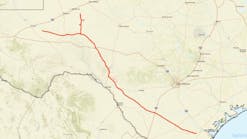Sam Fletcher
OGJ Senior Writer
Front-month crude contracts jumped June 30 to “fake” intraday highs of $73.38/bbl on the New York Mercantile Exchange—the highest this year—and $73.50/bbl on the International Petroleum Exchange through unauthorized trades by an employee at a subsidiary of PVM Oil Associates Ltd., London. PVM subsequently announced a loss of almost $10 million.
The August contract for benchmark US light, sweet crudes traded through a $4.48/bbl high-low price difference June 30 before closing at $69.89/bbl, down $1.60 for the day on NYMEX. In London, the August IPE contract for North Sea Brent crude retreated $1.69 to $69.30/bbl that same day. Prices continued to drop during the next two sessions with the NYMEX and ICE contracts closing at $66.73/bbl and $66.65/bbl, respectively, on July 2.
“After the PVM high, it was a downhill race,” said Olivier Jakob at Petromatrix, Zug, Switzerland, with the NYMEX crude contract losing $3.53/bbl during the week and closing $7.75/bbl lower than the June 30 high. “Brent lost $3.31/bbl during the week,” said Jacob. Prices were still falling in early trading July 6, as the New York market resumed business after the 3-day US Independence Day holiday, July 3-5. In Houston, analysts at Raymond James & Associates Inc. said, “Crude oil is trading around a 5-week low as the US dollar strengthened and concerns of a prolonged global economic slowdown continue to impact sentiment.”
At KBC Market Services, a division of KBC Process Technology Ltd. in Surrey, UK, analysts asked, ““How can a trader enter into futures contracts representing 18 million bbl of oil at a time of day—early morning—when normally only 500,000 bbl are traded, without anybody thinking something was strange? Where were the ICE monitors and the Financial Services [Authority that regulates most aspects of UK financial dealing]?” Concerning the usefulness of those market regulators, KBC analysts said, “Their resemblance to a chocolate teapot is striking.”
‘A massive weapon’
On the other hand, with yet another rogue trader involved in unauthorized speculation that drove up crude prices on the futures markets, KBC analysts said, “A massive weapon has been handed to supporters of tighter regulation of futures markets, not just affecting oil but for other commodities, which are literally the raw material of economic prosperity.” They warned, “We haven’t heard the end of this.”
Jakob said, “The PVM trades had a relatively small impact by themselves but a greater subsequent impact on the chart formations. It is counterintuitive, but the net impact of the PVM fat fingers had a net negative impact (buying to a recent high, then selling and letting the world know the buying was fake) on the technical picture.” He said, “Technically, West Texas Intermediate took a beating” in the short trading week of June 29-July 2.
KBC analysts said, “With economic news still gloomy, oil demand sluggish, stocks plentiful, and no supply-side disruption in sight, we could be on the verge of a short term downward price correction.” They said, “There is a growing perception that although recovery will come, it will not be tomorrow.”
Bullish traders need a support level of $66/bbl “to keep some control of the game," Jakob said, but WTI dropped through that price level in “thin electronic trades” on July 3. He said, “WTI is now below the lower Bollinger [a band plotted two standard deviations away from a simple moving average], which could bring some support; but if another set of lower highs and lower lows are printed, it will need to look for the 50-day moving average as the next level of support around $63.70/bbl.”
He said July 6, “If $66/bbl can be [maintained] early in the week on the back of the new pipeline bombings in Nigeria, WTI will still face some strong resistance between $70-73/bbl. Hence on any early recovery, we would not expect very much apart from a consolidating range between $66-70/bbl. Last year the peaks were reached in the first half of July, and this might prompt some expectations that a similar seasonal pattern is occurring this year.”
Meanwhile, in Nigeria a presidential offer of amnesty had encouraged some hope that passions might cool in the Niger Delta. But attacks on oil installations by hardcore militants “have continued rather than stopped,” said Jakob. “Over the weekend [July 4-5] a Royal Dutch Shell PLC installation in the Eastern Delta (Bonny) was attacked and overnight a Chevron Corp. installation as well. The production levels in Nigeria are falling to multiyear lows and getting closer to the day when only [offshore floating production, storage, and offloading vessels] FPSOs are left running,” he said.
(Online July 6, 2009; author’s e-mail: samf@ogjonline.com)

